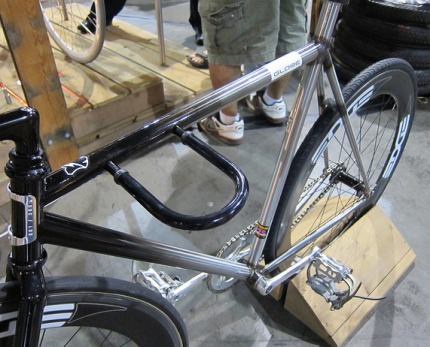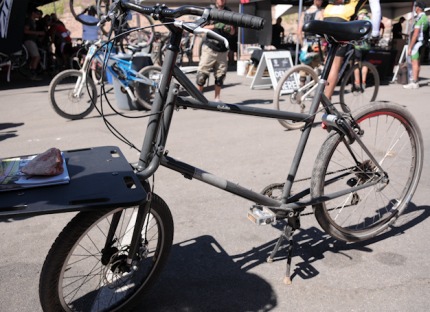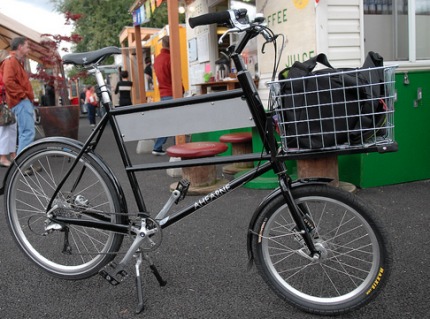Two new bike models shown at the Interbike trade show in Las Vegas last week borrow major design elements from Portland-based custom bike builders. As we noted with Electra’s Ticino line, being inspired by small builders is nothing new, but I feel the two examples below warrant more attention.
The first example is from Globe, a brand owned and developed by industry juggernaut Specialized Bicycles Inc. I unfortunately missed this bike while at the show, but came across an image of it on Flickr. The bike (see photo below) is an urban fixed-gear with deep-dish carbon rims and a riser bar that has one very familiar feature — a u-lock integrated into the top tube…

(Photo by Ricky deLeyos/Flickr)
The integrated u-lock looks like it was inspired by a design first dreamed up last October by Tony Pereira of Pereira Cycles. Tony integrated a u-lock into his winning entry into the Constructor’s Design Challenge of the Oregon Manifest event last October. Here’s Tony’s version (which, unlike the Globe, also locks the steering) …

The Globe bike was designed by Garrett Chow, a notable figure in the urban fixed gear scene as a member of MASH SF and who now does brand management and creative direction for Globe’s “Roll” line. I asked Chow this morning about his inspiration for the u-lock feature. He said he hadn’t even seen the Pereira bike until someone pointed it out to him yesterday. Chow said he thought Pereira’s idea was “really cool,” but it wasn’t part of his inspiration. “It was just something I thought of… I’m always trying to figure out ways to do things quickly.” Chow added that he put the u-lock on the top tube so riders could quickly lock to parking meters.
Pereira said he felt a little bit “ripped off” after seeing the Globe Bike. “To see Specialized come out with one at Interbike, 11 months later, is sort of flattering, but also a bit disappointing,” he told me on the phone yesterday, “I feel a little bit ripped off.”
Interestingly, back in October I asked noted bike designer Sky Yaeger (one of the judges of the Constructor’s Design Challenge event where Pereira’s bike debuted) whether or not the entries would impact bike design industry-wide. Here’s the answer she gave:
“Yes, because the big guys are never first to market with anything cool, so they will be looking at these bikes and we’ll see everything from blatant rip-offs to barely disguised rip-offs of them in their respective lines next year.”
[Bryant Bainbridge, who works in product creation for Specialized Bicycles was also a judge at the Oregon Manifest event.]
Read more responses to the Globe Bike from Pereira and others on bundobiker’s Flickr photo page.
The next example comes from Civia, a bike brand owned and developed by Quality Bicycle Products. Civia’s new Halsted cargo bike is based on the tried and true cycle-truck design where a large front rack is attached to the frame instead of the forks (which makes for a sturdier rack and allows the front wheel to turn independently of the load). Here’s the Halsted at the Outdoor Demo…

(Photo © J. Maus)
The cycle truck concept has been around for decades, but was brought back into the limelight earlier this year by Portland builder Joseph Ahearne of Ahearne Cycles. Ahearne unveiled his Cycle Truck at the Pedal Nation Bike Show back in April.

(Photo © J. Maus)
When speaking to Civia brand manager Scott Thayer about the Halsted at Interbike, he didn’t hide the fact that he was inspired by Ahearne’s design. Thayer said Civia is making the cycle truck more accessible to the masses by offering it for a fraction of the price of the Ahearne model — about $1,000 retail for the Civia versus about $2,700 for an Ahearne.
I stopped by Ahearne’s shop yesterday to find out what he thinks about the Halsted. “When I first saw it I was kind of frustrated,” he said, “But the more I think about it, if anything, it will raise awareness about this type of bike in general.” Ahearne thinks having a larger company educate the bike-buying public about cycle trucks could actually help his sales (sort of like how Starbucks made good coffee popular and spurred success of smaller roasters). But, Ahearne adds, this phenomenon of being copied by larger companies has a point of diminishing returns. “If Trek and Specialized start making a cycle truck, I’m screwed.”
UPDATE, 11:54 a.m.: Just out of curiousity, I asked local intellectual property attorney Shawn Kolitch of Kolisch Hartwell, P.C. what he thought about this. Here’s what he said (edited for brevity):
“Pereira’s integrated u-lock and Ahearne’s integrated front rack are potentially protectable by intellectual property law, if they were new to the bike industry when Pereira and Ahearne introduced them…
In the U.S., inventors are given a one-year grace period to file a patent application after first publicly disclosing the invention. Therefore, if Tony’s first public disclosure of the integrated u-lock was last October, he could still apply for a U.S. patent now. Similarly, if Ahearne introduced his cycle truck earlier this year, he could still apply for a U.S. patent on any aspects of his design that were new. One year after public disclosure, U.S. patent rights are lost and the invention becomes part of the public domain.”

